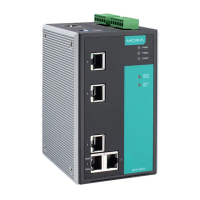Time Server IP/Name
Setting Description Factory Default
IP address or name of
time server
The IP or domain address (e.g., 192.168.1.1,
time.stdtime.gov.tw, or time.nist.gov).
None
IP address or name of
secondary time server
The Moxa switch will try to locate the secondary NTP server if
the first NTP server fails to connect.
Enable NTP/SNTP Server
Enable/Disable Enables SNTP/NTP server functionality for clients Disabled
IEEE 1588 PTP
The following information is taken from the NIST website at http: //ieee1588.nist.gov/intro.htm:
“Time measurement can be accomplished using the IEEE Standard for a Precision Clock Synchronization
Protocol for Networked Measurement and Control Systems (IEEE 1588-2008) to synchronize real-time clocks
incorporated within each component of the electrical power system for power automation applications.
IEEE 1588, which was published in November 2002, expands the performance capabilities of Ethernet networks
to control systems that operate over a communication network. In recent years an increasing number of
electrical power systems have been using a more distributed architecture with network technologies that have
less stringent timing specifications. IEEE 1588 generates a master-slave relationship between the clocks, and
enforces the specific timing requirements in such power systems. All devices ultimately get their time from a
clock known as the grandmaster clock. In its basic form, the protocol is intended to be administration free.”
How does an Ethernet switch affect 1588 synchronization?
The following content is taken from the NIST website at http: //ieee1588.nist.gov/switch.htm:
“An Ethernet switch potentially introduces multi-microsecond fluctuations in the latency between the 1588
grandmaster clock and a 1588 slave clock. Uncorrected these fluctuations will cause synchronization errors.
The magnitude of these fluctuations depends on the design of the Ethernet switch and the details of the
communication traffic. Experiments with prototype implementations of IEEE 1588 indicate that with suitable
care the effect of these fluctuations can be successfully managed. For example, use of appropriate statistics in
the 1588 devices to recognized significant fluctuations and use suitable averaging techniques in the algorithms
controlling the correction of the local 1588 clock will be the good design means to achieve the highest time
accuracy.”
Can Ethernet switches be designed to avoid the effects of these
fluctuations?
A switch can be designed to support IEEE 1588 while avoiding the effects of queuing. In this case two
modifications to the usual design of an Ethernet switch are necessary:

